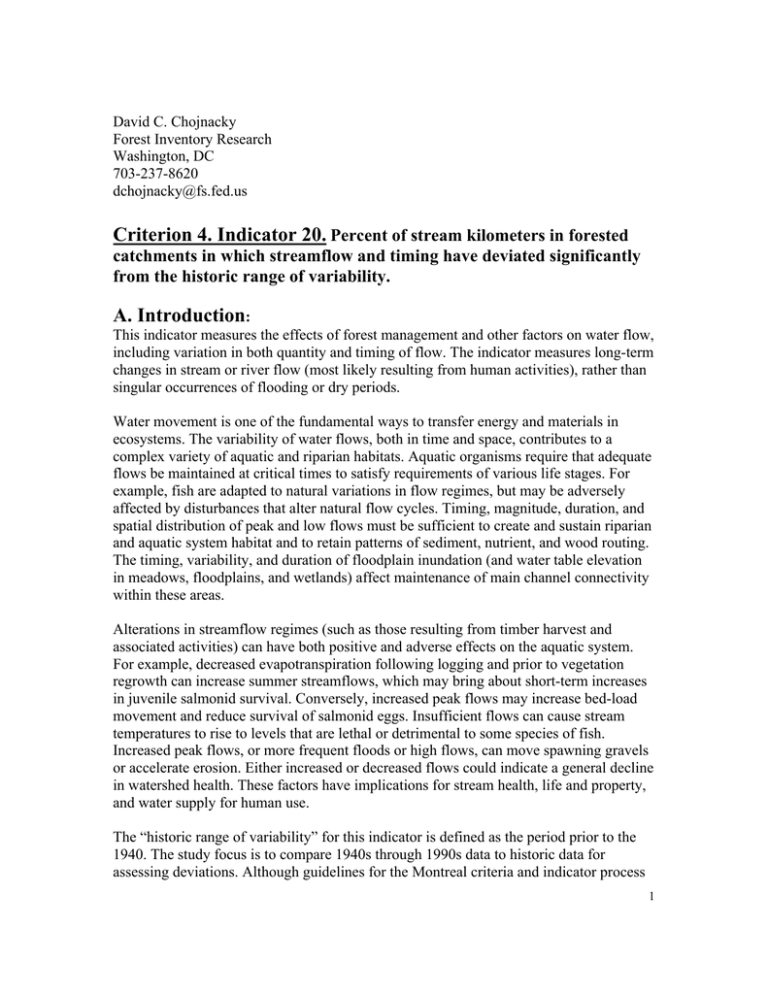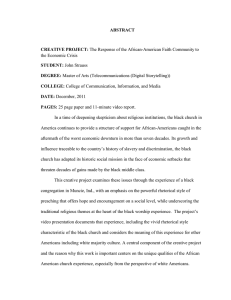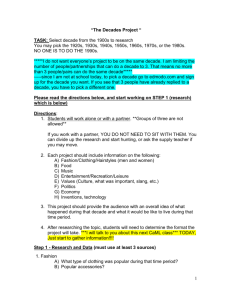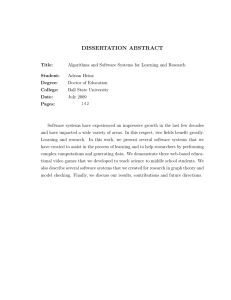Criterion 4. Indicator 20.
advertisement

David C. Chojnacky Forest Inventory Research Washington, DC 703-237-8620 dchojnacky@fs.fed.us Criterion 4. Indicator 20. Percent of stream kilometers in forested catchments in which streamflow and timing have deviated significantly from the historic range of variability. A. Introduction: This indicator measures the effects of forest management and other factors on water flow, including variation in both quantity and timing of flow. The indicator measures long-term changes in stream or river flow (most likely resulting from human activities), rather than singular occurrences of flooding or dry periods. Water movement is one of the fundamental ways to transfer energy and materials in ecosystems. The variability of water flows, both in time and space, contributes to a complex variety of aquatic and riparian habitats. Aquatic organisms require that adequate flows be maintained at critical times to satisfy requirements of various life stages. For example, fish are adapted to natural variations in flow regimes, but may be adversely affected by disturbances that alter natural flow cycles. Timing, magnitude, duration, and spatial distribution of peak and low flows must be sufficient to create and sustain riparian and aquatic system habitat and to retain patterns of sediment, nutrient, and wood routing. The timing, variability, and duration of floodplain inundation (and water table elevation in meadows, floodplains, and wetlands) affect maintenance of main channel connectivity within these areas. Alterations in streamflow regimes (such as those resulting from timber harvest and associated activities) can have both positive and adverse effects on the aquatic system. For example, decreased evapotranspiration following logging and prior to vegetation regrowth can increase summer streamflows, which may bring about short-term increases in juvenile salmonid survival. Conversely, increased peak flows may increase bed-load movement and reduce survival of salmonid eggs. Insufficient flows can cause stream temperatures to rise to levels that are lethal or detrimental to some species of fish. Increased peak flows, or more frequent floods or high flows, can move spawning gravels or accelerate erosion. Either increased or decreased flows could indicate a general decline in watershed health. These factors have implications for stream health, life and property, and water supply for human use. The “historic range of variability” for this indicator is defined as the period prior to the 1940. The study focus is to compare 1940s through 1990s data to historic data for assessing deviations. Although guidelines for the Montreal criteria and indicator process 1 require assessing forested catchments only, time and funding did not permit separation of forest from nonforest catchments. Instead, the study is a first step in compiling and developing methodology for analyzing available water flow data at a national scale. B. Definitions/background: Evapotranspiration – Long-term trends in streamflow are affected by changes in vegetation. Evapotranspiration is water loss to the atmosphere through evaporation of precipitation intercepted by plant and other surfaces and through transpiration of moisture taken up from the soil via roots and plant conducting tissues. Disturbance and compaction of soils and changes in vegetation can alter how much evaporates to the air or is transpired through plants. Such changes to hydrologic interactions and processes are tied to degradation of aquatic and riparian habitats and alterations of streamflow regimes and water quality. Hydrologic Unit Code (HUC) – The U.S. Geological Survey (USGS) has developed a hierarchical coding system to identify geographic boundaries of drainage areas of various sizes. The United States is divided and subdivided into successively smaller hydrologic units (HUCs), which are nested within each other. The smallest units are called HUC-8 watersheds, which are nested within HUC-6 basins, which are nested within HUC-4 subregions, which are within HUC-2 regions. The largest and most inclusive unit, the HUC-2 or region, is a major geographic area that contains either the drainage area of a major river (such as the Missouri region) or the combined drainage areas of a series of rivers (such as the Texas-Gulf region). There are 21 regions, 222 subregions, 352 basins, and 2,150 watersheds in the United States. HUCs provide a uniform, nationwide area framework for studying the Nation’s hydrology (http://water usgs.gov/GIS/huc.html). Interception – Precipitation is “intercepted or captured” on plant surfaces, which then may either evaporate or fall to the ground. Decreases in interception (such as through vegetation removal) can affect how much and where surface runoff occurs and how much water evaporates to the air or is transpired through plants. Such changes to hydrologic interactions and processes are tied to degradation of aquatic and riparian habitats. High Flow – Water flow data is typically recorded as a series of daily maximums for the center of a stream at a gauging station. The 95th percentile of this data for some period is defined as high flow for this study. This represents an upper value but avoids extremes. Low Flow – Water flow data is typically recorded as a series of daily maximums for the center of a stream at a gauging station. The 5th percentile of these data for some period is defined as low flow for this study. This represents a lower value but avoids extremes. C. Data/Analysis Methods Assembling water flow data was a first step and was no simple task for the entire Nation. The U.S. Geological Society’s NWISWeb (http://waterdata.usgs.gov/nwis) is the most extensive database. This data was obtained through a private company 2 (http://www.hydrosphere.com) for the lowest reach or most downstream gauging station for 1,960 HUC-8 watersheds. Data in included 20,243,678 daily maximum water flow measurements, with average of 2,500 per decade and median of 3,508 per decade. For each decade, the 5th and 95th percentiles were selected for respective low and high flows. Resulting data summary included 8,081 observations for decades from 1870 to 2000. Low and High water flows of the decades from 1870s through 1930s were averaged and defined as the “historic mean” for comparison to later decades. Some quirks and questions were found in the data that could be examined further with USGS database administrators, but these were left for later studies. The database structure of grouping by States also posed some problems when a single HUC-8 straddled State boundaries. However, for a huge database spanning 130 years it is in remarkably good shape. An “average historic” or reference water flow was calculated by averaging 5th and 95th percentiles, respectively within each HUC-8, for all data from 1870s to 1930s decades. However, the early program had little continuity, as only 20 percent of the gauging stations included more than two decades of data and half included just 1 decade (table 20.1). Fluctuation in USGS monitoring program is probably the biggest challenge in using this data for long-term trend analysis. Comparison of the “historic average” to later decades was done on a station-by-station basis, which reduced the analysis to only 506 of the 1,960 HUC-8 watersheds having some data before and after 1940 (figure 20.1). Although some data were available for the 2000 decade, these were dropped to be more consistent with the previous full decades. Although Indicator 20 was intended for analyses of “forested catchments”, linking to Forest Inventory and Analysis (FIA) data did not seem reasonable at this time. Because FIA data is not yet classified by HUC-8 watershed, the link would require cross-walking water data to FIA county data. There seemed no obvious way to do this in proportion to HUC-8 and county areas, because the HUC-8 data represented the lowest watershed reach, which was not an area-based rate conducive to averaging. Linkage to other remote sensing databases of forest cover was beyond the scope and timeframe of this study. Therefore, this analysis was done on 506 HUC-8 watersheds without regard to amount of forest area within each catchment. 3 Comparison of flow rates between decades and historic average was done through a ratio statistic: fr = FD + 1 R +1 where f r = flow ratio for either low or high flow rates per decade th (1) th FD = flow rate of either 5 percentile (low) or 95 percentile (high) for decades (cfs) R = reference or historic flow rate (before 1940) of respective low and high flow rates averaged over available decades (cfs) Note : "1" added to denominator (and numerator for consistency) to avoid division by zero The ratio was a convenient way to compare differences among flow rates that spanned orders of magnitude. Examining differences in log units motivated it, which is mathematically equivalent to the log of a ratio. A ratio statistic of 1 meant no change from the reference period. The low flow ratio statistic ranged from near zero to 406 but median was 1.076. High flow ratio ranged from near zero to over 4,000 but median was 1.078. The ratio was most useful for transforming the data to ordinal ranks for frequency analysis, instead of having to deal with huge data ranges in water flow units. A limitation of the ordinal ranks was no distinction in the magnitude of the flow rate for a given ratio, but for this study it seemed more important to detect changes in water flow trend regardless of size of the stream or river. A frequency distribution of the ratios divided into 100 groups or percentiles was used to judge deviation from reference flows (figure 20.2). Flow ratios within 0.5 to 1.5 were chosen for comparison to those above and below that range, which generated three ratio classes for analyses: < 0.5, 0.5 to 1.5, and >1.5. Twenty-five percent of the data had flow ratios > 1.5. Five and ten percent had ratios < 0.5 for high and low flows, respectively. The purpose of the analysis was to examine frequency distributions for changes among the three ratio classes for the entire United States from decade to decade of 1940s to 1990s. This was a broad-scale analysis across the United States looking for patterns of change in low and high streamflow rates. D. Results/Discussion Low- and high-flow spatial patterns are apparent across the United States, but declining numbers of gauging stations in recent decades having historic reference measurements complicate interpretation. The most prominent pattern is an increase in numbers of stations that exceed a 1.5 flow ratio in 1970s, 1980s, and 1990s for low flow (figure 20.3). Furthermore, the increase occurs mainly in the eastern United States. A similar high-flow pattern is not obvious but it is interesting that numbers of flow ratios > 1.5 remain similar from decade to decade in spite of declining sample sizes (figure 20.4). 4 Since there seemed a time trend (at least for low flow rates) among decades within the three ratio classes (<0.5, 0.5 to 1.5, > 1.5), a proportion was devised for further study. The proportion focused on relative differences from decade to decade by adjusting for sample sizes: n ) pi = 3 i ∑ ni i =1 where (2) i = 3 flow - ratio classes, < 0.5, 0.5 to 1.5, > 1.5 ni = number of observations within each flow class within each decade A standard error was also calculated for the proportion: ) pi (1 − pˆ i ) ˆ SE ( pi ) = 3 ∑ ni − 1 i =1 (3) Comparison of 95 percent confidence intervals [ pˆ i ± 1.96 SE ( pˆ i ) ] for ratio-class proportions indicates a statistical difference (assuming random sampling) when confidence intervals do not overlap (figure 20.5). For low flows, a drop in proportions ( p̂ i ) for midrange flow ratios (0.5 to 1.5) for the 1970s, 1980s, and 1990s and corresponding increase in proportions for large flow ratios (>1.5) indicates “low stream flows” may be increasing in recent decades. This means the 5th percentile in flow rates was a higher value in the 1970s, 1980s, and 1990s than it was in the 1940s, 1950s, and 1960s. This suggests runoff is increasing or becoming more stable in recent decades. Interpretation of this pattern will require more analysis of precipitation and land disturbance patterns. Trends in high-flow proportions are not evident in this broad-scale analysis. Perhaps, peak flows are more controlled by climate factors and less subject to landscape disturbance. D. Conclusion This study summarized more than 20 million water flow measurements into 36 proportions to show a trend in low flows from the 1970s to the 1990s in comparison to pre-1940 flow rates. Much more can be explored with this data. Future work ought to consider three things: 1. FIA data should be classified and analyzed with HUC 8 units. This would link forest conditions to water flow data interpretation. 2. More study of “statistics for comparison” is needed. The ad hoc ratios, three flow ratio classes, and proportions (with ratio classes) show some promise for use of ratio statistics, but more rigorous statistical development is needed. 5 3. Only a fourth of the available water data was used because pre-1940 reference was lacking for so many gauging stations. Other statistical methods (such as times series analysis of running means) should be explored for making use of more data. Table 20.1. Historic water flow data ranged from the 1870s to 1930s, but only 20 percent of the gauging stations included more than 2 decades of data in the historic average. Coefficient of variation of were higher for low flows than for high flows. No. of decades averaged 1 2 3 4 5 6 7 No of stations 295 182 78 35 6 3 2 Percent of total stations 49.1 30.3 13.0 5.8 1.0 0.5 0.3 Coefficient of Variation (%) Low flow High flow (5th percentile) (95th percentile) Mean Median Mean Median 47 47 67 52 40 12 31 33 40 23 17 12 30 26 25 33 22 11 19 18 21 32 22 11 6 HUC 8 selected HUC 8 not selected Figure 20.1. Water flow data was available for 1,960 HUC-8 watersheds but only 506 (26 percent) met the study requirement of having comparison data before and after 1940. 7 Low Flow - m nt ile -- -- 80 -- -P er ce 60 40 20 10 Flow Ratio < 0.5 0.5 to 1.5 > 1.5 m 0 0.0 0.5 1.0 1.5 2.0 2.5 3.0 Flow Ratio: (decade value) / (< 1940 mean) 100 High Flow - 75 m ile -- -- 80 -P er ce nt 60 -- 40 Flow Ratio -- Cumulative Freq (%) Figure 20.2. Deviation from reference flow was determined as 0.5 above or below flowratio statistic. A ratio of 1 indicates flow does not deviate from average reference flow before 1940. Both low and high flow rates have the same percentage of values above 1.5 but low flow has 5 percent more below 0.5. 75 -- Cumulative Freq (%) 100 20 < 0.5 0.5 to 1.5 > 1.5 5 m 0 0.0 0.5 1.0 1.5 2.0 2.5 3.0 Flow Ratio: (decade value) / (< 1940 mean) 8 Low Flow Ratio: < 0.5 0.5 to 1.5 > 1.5 cfs_fia.sas---04/03/02 1940s 1950s 1960s 1990s 1980s 1970s 9 500 481 429 400 403 369 Frequency Figure 20.3. Low waterflow patterns over the past 6 decades are evident, particularly for higher ratios (>1.5) in the South, but decreasing numbers of monitoring stations from 1940s to 1990s complicates assessment. Low Flow Ratio 460 360 328 total < 0.5 0.5 to 1.5 > 1.5 338 303 300 222 212 187 200 137 100 78 69 63 34 124 111 84 42 44 37 27 0 1940s 1950s 1960s 1970s 1980s 1990s 10 High Flow Ratio: < 0.5 0.5 to 1.5 > 1.5 cfs_fia.sas---04/03/02 1940s 1950s 1960s 1990s 1980s 1970s 11 500 481 High Flow Ratio 460 429 403 Figure 20.4. High waterflow patterns over the past 6 decades are not clearly evident but decreasing numbers of monitoring stations from 1940s to 1990s complicates assessment. Frequency 400 336 360 336 total < 0.5 0.5 to 1.5 > 1.5 338 311 300 271 250 225 200 127 99 100 18 25 114 93 25 91 90 18 20 22 0 1940s 1950s 1960s 1970s 1980s 1990s cfs_fia.sas---04/03/02 12 Low Flow Ratio < 0.5 0.5 to 1.5 > 1.5 Proportion of Total 0.8 0.7 0.6 0.5 0.4 0.3 0.2 0.1 0.0 40 50 60 70 80 90 40 50 60 70 80 90 40 50 60 70 80 90 Decade (40=1940s, 50=1950s, etc.) High Flow Ratio < 0.5 0.5 to 1.5 > 1.5 Proportion of Total 0.8 0.7 0.6 0.5 0.4 0.3 0.2 0.1 0.0 40 50 60 70 80 90 40 50 60 70 80 90 40 50 60 70 80 90 Decade (40=1940s, 50=1950s, etc.) Figure 20.5. An increasing trend toward higher peak flows (more ratios > 1.5) in the lowflow ratio (upper chart) is evident when standardizing data as proportions for each decade. On the other hand, there is no trend among high-flow ratios (lower chart). The error bars are 95 percent confidence intervals for each proportion, assuming a simple random sample. 13





